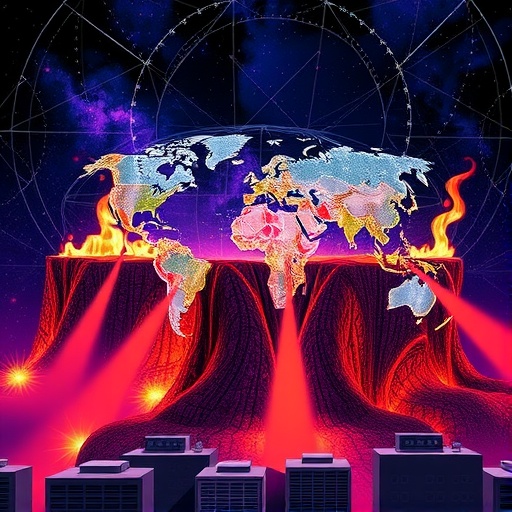In a striking advancement that challenges prevailing geological paradigms, a team led by Tulane University researchers has uncovered why certain regions of the Earth’s continental crust exhibit remarkable strength and resist the forces that attempt to fracture them. Their research, recently published in Nature, sheds light on the complex interplay between geological history and tectonic dynamics that govern continental breakup, a process central to understanding plate tectonics and seismic activity worldwide.
The study focuses on the East African Rift system, a dynamic tectonic boundary where the African continent is gradually being pulled apart. This region serves as a rare natural laboratory where scientists can directly observe and analyze the processes driving continental rifting, a phenomenon that usually occurs over millions of years and is difficult to witness in active stages elsewhere on the planet. Within this rift, the Turkana Depression—straddling Kenya and Ethiopia—has presented an enigma: despite experiencing previous episodes of intense stretching and thinning, some portions of the crust here resist further deformation.
Contrary to longstanding scientific expectation that thinned and stretched segments of tectonic plates become zones primed for continued rifting and eventual continental separation, the research team discovered that the Turkana region’s crust is surprisingly resilient. This resilience, they found, is linked to a significant heating event that occurred approximately 80 million years ago. During this event, volcanic activity facilitated extensive dehydration of the plate’s deep layers, extracting water and carbon dioxide molecules, which fundamentally altered its physical properties.
This dehydration process increased the rigidity and strength of the crust by reducing its capacity to deform plastically under stress. In geological terms, the removal of volatile compounds like H2O and CO2 results in faster seismic wave propagation velocities and increased mechanical resistance. Such dehydration had the effect of “healing” zones previously weakened by stretching, thereby preventing them from becoming sites of continued thinning or rupture during the current tectonic regime.
Professor Cynthia Ebinger, a leading authority in Earth and Environmental Sciences at Tulane University, highlighted the multidisciplinary approach that enabled these findings. The research leveraged a broad spectrum of observations, including seismic tomography, GPS measurements of plate motions, and earthquake monitoring networks, to construct detailed three-dimensional models of crustal behavior beneath the Turkana Depression. These models revealed how deformation and volcanism conspicuously diverted away from the ancient thinned zones, circumventing areas that scientists had assumed vulnerable and instead creating deep sedimentary basins elsewhere along the rift.
Moreover, the study elucidates the role of volcanism not just as a surface phenomenon but as a critical driver of tectonic plate properties at depth. Volcanic eruptions extracted volatiles from the lithosphere—Earth’s rigid outer shell—during a large igneous province event, thereby reconfiguring the mechanical architecture of the crust. This reconfiguration manifests today as a ‘strengthened’ crustal segment, one that defies the classical models predicting its inevitable breakdown under extensional forces.
Martin Musila, who pursued part of this research during his doctoral studies at Tulane, elaborated on the broader implications: “Our findings reveal a tectonic paradox whereby past failed rifts, previously considered geological weaknesses, instead act as reinforcing agents for the current crust. This unexpected resilience significantly influences not only rift evolution but also associated geological hazards such as earthquakes and volcanic eruptions.”
The implications extend well beyond academic curiosity. Understanding how ancient rifting episodes condition the mechanical behavior of continental plates informs predictive models regarding seismic hazard zones, improved resource exploration, and interpretations of Earth’s geodynamic history. For example, the Gulf Coast and other ancient rift platforms worldwide can now be re-examined through the lens of dehydration-induced strengthening to better assess mineral and hydrocarbon prospects.
Collaborating institutions, including the University of Montana, Imperial College London, Addis Ababa University, and Kenyan universities, contributed to the comprehensive synthesis of data that formed the foundation of this work. Their collective expertise spanned seismology, geodesy, geodynamics, and volcanology, enabling an integrated interpretation that was unattainable by isolated studies.
Funded by the U.S. National Science Foundation and the U.K. Natural Environment Research Council, with additional support from the U.K. Global Challenges Research Fund and the Kenyan National Commission for Science, Technology, and Innovation, the project exemplifies international scientific cooperation addressing fundamental Earth science questions with practical applications.
Looking ahead, the research team advocates for expanded investigations into how varying thermal and chemical histories across the globe’s tectonic plates influence their behavior under stress. Such knowledge could redefine models of continental breakup, plateau uplift, and mantle convection patterns, with ramifications for understanding Earth’s tectonic evolution and risk mitigation strategies in active rift zones.
This paradigm-shifting research illustrates that the Earth’s lithosphere is more dynamic and complex than traditionally conceived. Past geological processes leave indelible imprints, modifying the fundamental properties of the planet’s crust in ways that dictate the future tectonic fate of continents.
Subject of Research: Not applicable
Article Title: The importance of past rifting in large igneous province development
News Publication Date: 5-Nov-2025
Web References: https://www.nature.com/articles/s41586-025-09668-7
References: DOI: 10.1038/s41586-025-09668-7
Image Credits: Cynthia Ebinger/Tulane University
Keywords: Continental drift, Plate tectonics, Earth sciences, Geodynamics, Tectonic plates, Tectonic uplift, Seismology, Subsidence, Continental crust, Crustal composition, Earth crust, Earth surface, Upper mantle, Earth structure, Physical geology, Geological events, Geography, Earth systems science




